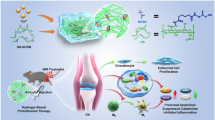Abstract
Purpose. The present study evaluated the size-dependency of DL-lactide/glycolide copolymer (PLGA) particulates for an intra-articular delivery system on phagocytosis in the rat synovium after administering directly into the joint cavity. We also investigated the biocompatibility of PLGA particulate systems administered directly into the joint cavity of the rat.
Methods. Fluoresceinamine bound PLGA (FA-PLGA) nanospheres and microspheres were prepared by the modified emulsion solvent diffusion method. The suspension of these particulate systems was administered into the rat-joint cavity and the biological action of the synovium was evaluated by histological inspection and fluorescence microscopy.
Results. A colloidal suspension of the FA-PLGA nanospheres, with a mean diameter of 265 nm, was phagocytosed in the synovium by the macrophages infiltrated through the synovial tissues. The phagocytosed nanospheres were delivered to the deep underlying tissues. An aqueous suspension of the FA-PLGA microspheres, with a mean diameter of 26.5 μm, was not phagocytosed in the macrophages. The macrophages slightly proliferated in the epithelial lining synovial-cells and the microspheres were covered with a granulation of multinucleated giant cells. The molecular weights of the polymer in these particulate systems were slowly reduced in the synovium. Localized inflammatory responses were almost undetected.
Conclusions. PLGA nanospheres should be more suitable for delivery to inflamed synovial tissue than microspheres due to their ability to penetrate the synovium. PLGA particulate systems with biocompatibility in the joint can provide local-therapy action in joint diseases in a different manner depending on the size of the system.
Similar content being viewed by others
REFERENCES
N. C. Phillips, P. Page-Thomas, C. G. Knight, and J. T. Dingle. Liposome incorporated corticosteroids. II. therapeutic activity in experimental arthritis. Ann. Rheum. Dis. 38:553–557 (1979).
Y. Mizushima, H. Miyake, K. Fujikawa, N. Ono, and K. Takayama. A highly topically active corticosteroid, Arzneim.-Forsch/Drug Res. (I) 30:274–275 (1980).
D. J. Burgess, S. S. Davis, and E. Tomlinson. Potential use of albumin microspheres as a drug delivery system. I. preparation and in vitro release of steroids. Int. J. Pharm. 39:129–136. (1987); b) D. J. Burgess and S. S. Davis. Potential use of albumin microspheres as a drug delivery system. II. in vivo deposition and release of steroids. 46:69-76 (1988).
J. H. Ratcliffe, I. M. Hunneyball, C. G. Wilson, A. Smith, and S. S. Davis. Albumin microspheres for intra-articular drug delivery: investigation of their retention in normal and arthritic knee joints rabbits. J. Pharm. Pharmacol. 28:290–295 (1987).
M. Tuncay, S. Calis, H. S. Kas, M. T. Ercan, H. Erturk, and A. A. Hincal. Dicrofenac sodium incorporated biodegradable microspheres. II: anti-inflammatory activity in the knee joints of rabbits, “challenges for drug delivery and pharmaceutical technology, Tokyo”: 188 (1998) b) idem Dicrofenac sodium incorporated PLGA (50:50) microspheres: formulation considerations and in vitro/in vivo evaluation. Int. J. Pharm. 195:179-188 (2000). c) M. Tuncay, S. Calis, H. S. Kas, M. T. Ercan, I. Peksoy, and A. A. Hincal. In vitro and in vivo evaluation of dicrofenac sodium loaded albumin microspheres. J. Microencupsulation 17:145-155 (2000).
A. S. Shanbhag, J. J. Jacobs, J. Black, J. O. Galante, and T. T. Glant. Macrophage / particle interactions: effect of size, composition and surface area. J. Bio. Material Res. 28:81–90 (1994).
C. J. Coester, K. Langer, H. V. Briesen, and J. Kreuter. Gelatin nanoparticles by two step desolvation-a new preparation method, surface modifications and cell uptake. J. Microencupsulation 17:187–193 (2000).
M. J. D'Souza and P. DeSouza. Preparation and testing of cyclosporine microsphere and solution formulations in the treatment of polyarthritis in rats. Drug Dev. Ind. Pharm. 24:841–852 (1998).
P. Goupille, F. Perin, J.-P. Valat, and A. L. Pape. Macrophage targeting with-99mTc-labeled J001 for scintigraphy of joint inflammation in ovalbumin induced arthritis in rabbits. Clin. Exp. Rheum 15:269–274 (1997).
K. E. Brown, K. Leong, C.-H. Huang, R. Dalal, G. D. Green, H. B. Haimes, P. A. Jimenez, and J. Bathon. Gelatin/chondroitin 6-sulfate microspheres for the delivery of therapeutic proteins to the joint. Arthritis Rheum. 41:2185–2195 (1998).
G. Linck and A. Porte. Cytophysiology of the synovial membrane: distinction of two cell types of the intima revealed by their reaction with horseradish peroxidase and iron saccharate in the mouse. Biol. Cell. 42:147–152 (1981).
G. Meachim and G. Brooke. The synovial response to intraarticular Co-Cr-Mo particles in guinea pigs. Biomaterials. 4: 153–159 (1983).
E. Horisawa, K. Kubota, I. Tuboi, K. Sato, H. Yamamoto, H. Takeuchi, and Y. Kawashima. Size-dependency of DL-lactide/glycolide copolymer particulates for intra-articular delivery system on phagocytosis in rat synovium, “annual meeting of the academy of pharmaceutical science and technology, Tokyo”:168 (2001).
Y. Kawashima, H. Yamamoto, H. Takeuchi, T. Hino, and T. Niwa. Properties of a peptide containing DL-lactide/glycolide copolymer nanospheres prepared by novel emulsion solvent diffusion method. Eur. J. Pharm. Bio. 45:41–48 (1998).
H. Murakami, M. Kobayashi, H. Takeuchi, and Y. Kawashima. Preparation of poly (DL-lactide-co-glycolide) nanoparticles by modified spontaneous emulsification solvent diffusion method. Int. J. Pharm. 187:143–152 (1999).
H. Senda, E. Sakuma, I.Wada, H. J. Wang, H. Maruyama, and N. Matsui. Ultrastructural study of cells at the synovium-cartilage junction: response of synovial cells of the rat knee joint to intraarticularly injected latex particles. Acta Anat Nippon 74:525–535 (1999).
D. W. Howie, B. Manthey, S. Hay, and B. V. Roberts. The synovial response to intraarticular injection in rats of polyethylene wear particles. Clin. Orthop. 292:352–357 (1993).
B. J. Noble, A. G. Jones, M. A. Davis, C. B. Sledge, R. I. Kramer, and E. Livini. Leakage of radioactive particle systems from a synovial joint studied with a gamma camera. J. Bone Joint Surg. 65:381–389 (1983).
E. Horisawa, T. Hirota, S. Kawazoe, J. Yamada, H. Yamamoto, H. Takeuchi, and Y. Kawashima. Prolonged anti-inflammatory action of DL-lactide/glycolide copolymer nanospheres containing betamethasone sodium phosphate for an intra-articular delivery system in antigen-induced arthritic rabbit. Drug Deliv. Sys. 16:334 (2001).
Author information
Authors and Affiliations
Corresponding author
Rights and permissions
About this article
Cite this article
Horisawa, E., Kubota, K., Tuboi, I. et al. Size-Dependency of DL-Lactide/Glycolide Copolymer Particulates for Intra-Articular Delivery System on Phagocytosis in Rat Synovium. Pharm Res 19, 132–139 (2002). https://doi.org/10.1023/A:1014260513728
Issue Date:
DOI: https://doi.org/10.1023/A:1014260513728




